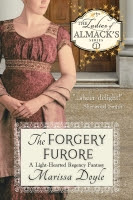Here’s another post in our ongoing series on Regency fabrics.
As I have in previous posts, I’ll be examining actual fabric samples glued into several earlier editions of Ackermann’s Repository, samples supplied by the manufacturers and published by Ackermann in order to boost the British cloth-making industry at a time when exporting British goods to Europe was almost impossible because of the Napoleonic war. I'll give you a close-up scan of each sample, the published description if available, and my own observations of the color, weight, condition, and similarity to present-day materials, to give you as close a picture as possible of what these fabrics are like.
So here we go!
We have four fabrics from October 1809; overall condition is very good, considering their age, apart from some browning on sample one where it was glued to the page.
No. 1. An entirely new corded muslin for morning and afternoon dresses, particularly adapted for the intermediate style of decoration for the morning wrap, or simple evening frock. Footing lace, or beading, is better calculated to ornament this article than needle-work. Many ladies, indeed, wear it without any embellishment, the rich and striking contrast of the cord being of itself a sufficient relief. Children’s trowsers, formed of this material, have a very neat and appropriate effect. It is sold by Messrs. Brisco and Powley, 103, New-bond-street, at 6s. per yard.
My comments: This is a very fine, lightweight fabric, but I expect that with the cording it will drape nicely. Because of its sheerness, it definitely requires a lining and/or a petticoat underneath.
No. 2. The Brazilian corded sarsnet, for robes, pelisses, and spencers. This article is also of novel production, and possesses a richness and consequence, which advance it, in point of elegance, beyond the plain sarsenet. The weight of the cord occasions it to fall with graceful adhesiveness over the figure, and divests it of that liability to crease, which is generally complained of in the plain sarsnet. We have seen Circassian robes, and short dancing dresses, formed of this tasteful article, to produce a most pleasing and attractive costume. It is half a yard wide, and 7s. 6d. per yard, and is sold by Mr. J. George, 19, Holywell-street, Strand.
My comments: I wish my scan had reproduced it better--this is lovely stuff indeed! It’s heavier and more opaque than the first sarsnet, with a soft sheen and very attractive pale buff color. But at only a half-yard wide, it would take a lot of it to make a gown—at 7definitely an upscale item.
No.3. A pomona green shawl print, in imitation of Indian silk, calculated for morning wraps or pelisses, as well as for gowns and robes. We beg leave to call the attention of our correspondents, not only to the taste and union of its pattern and shades, but also to the peculiar delicacy and silky softness of its fabric. It is ell-wide, and from 5s. to 5s. 6d. per yard; and may be purchased at Messrs. Brisco and Powley’s, 103, New-Bond-street.
My comments: Ah, pomona green, that most Regency of colors (if you're a Georgette Heyer fan, that is!) Again, the pattern reminds me of nothing so much as 1930s quilt fabric; what isn't as visible in this scan is that the fabric is finely diagonally ribbed. It's a little heavier in weight and indeed has a very silky hand due to the fineness of its threads and the tight weave.
No. 4. A rose-colored printed book-muslin, best calculated for the ball-room or evening party. It is formed in simple round dresses, or French frocks, trimmed with lace, white beads, or blended-white satin, and must be worn over white sarsnet, satin, or glazed cambric. This simple article will recommend itself, as well from the reasonableness of its price, as from its lively and animated effect. It is ell-wide, and 4s. per yard, and may be had at any respectable linen-drapers at the west end of this town.
My comments: This is nowhere as nice a fabric as the print above, being of a coarser weave (though the threads are finely woven)--no wonder readers are cautioned it must be worn over another fabric! It does not strike me as a fabric for a ball or evening dress, but evidently tastes have changed!
Subscribe to:
Post Comments (Atom)










2 comments:
I really appreciate your commentary. I read a nice textile encyclopedia but it's hard to tell what the fabrics feel like. I visited Plimoth Plantation recently and went around feeling all the clothes and asking the costume maker questions. He described fustian as being similar to brushed cotton. It was wool in the 17th c. but by the time Georgette Heyer's stories take place, it was cotton.
You're very welcome, QNPoohBear. I try to draw parallels to fabrics that are common today--I'm glad it's helpful.
Post a Comment